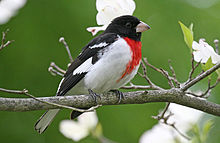Rose-breasted grosbeak
| Rose-breasted grosbeak | |
|---|---|
 |
|
| Adult male | |
 |
|
| Adult female | |
| Scientific classification | |
| Kingdom: | Animalia |
| Phylum: | Chordata |
| Class: | Aves |
| Order: | Passeriformes |
| Family: | Cardinalidae |
| Genus: | Pheucticus |
| Species: | P. ludovicianus |
| Binomial name | |
|
Pheucticus ludovicianus (Linnaeus, 1766) |
|
 |
|
| Range in northern America: Breeding range Migration only range Wintering range | |
| Synonyms | |
|
Zamelodia ludoviciana |
|
Zamelodia ludoviciana
The rose-breasted grosbeak (Pheucticus ludovicianus) is a large seed-eating grosbeak in the cardinal family (Cardinalidae). It is primarily a foliage gleaner. It breeds in cool-temperate North America, migrating to tropical America in winter.
The genus name Pheucticus is from Ancient Greek pheuktiko, " shy", from pheugo , "to flee, and the specific ludovicianus is from New Latin and refers to Louisiana.
Adult birds are 18–22 cm (7.1–8.7 in) long, span 29–33 cm (11–13 in) across the wings and weigh 35–65 g (1.2–2.3 oz). Grosbeaks measured during migration in the West Indies averaged 43 g (1.5 oz) while those banded in Pennsylvania average about 45 g (1.6 oz). There is very little sexual dimorphism in size, females were found to be marginally smaller in standard measurements but in some seasons were marginally heavier than males when banded in Pennsylvania. At all ages and in both sexes, the beak is dusky horn-colored, and the feet and eyes are dark.
The adult male in breeding plumage has a black head, wings, back and tail, and a bright rose-red patch on its breast; the wings have two white patches and rose-red linings. Its underside and rump are white. Males in nonbreeding plumage have largely white underparts, supercilium and cheeks. The upperside feathers have brown fringes, most wing feathers white ones, giving a scaly appearance. The bases of the primary remiges are also white. The coloration renders the adult male rose-breasted grosbeak (even while wintering) unmistakable if seen well.
The adult female has dark grey-brown upperparts – darker on wings and tail –, a white supercilium, a buff stripe along the top of the head, and black-streaked white underparts, which except in the center of the belly have a buff tinge. The wing linings are yellowish, and on the upperwing there are two white patches like in the summer male. Immatures are similar, but with pink wing-linings and less prominent streaks and usually a pinkish-buff hue on the throat and breast. At one year of age—in their first breeding season—males are scaly above like fully adult males in winter plumage, and still retail the immature's browner wings. Unlike males, females can easily be confused with the black-headed grosbeak (Pheucticus melanocephalus) where their ranges overlap in the central United States and south-central Canada. The rose-breasted grosbeak female has slightly darker brown markings on the underside, paler rather yellowish streaking on both the head and wings and paler, pinkish (rather than bi-colored) bill when compared to the female black-headed grosbeak. A potential confusion species also is the female purple finch (Haemorhous purpureus), but that species is noticeably smaller with a less robust bill and a notched tail.
...
Wikipedia

